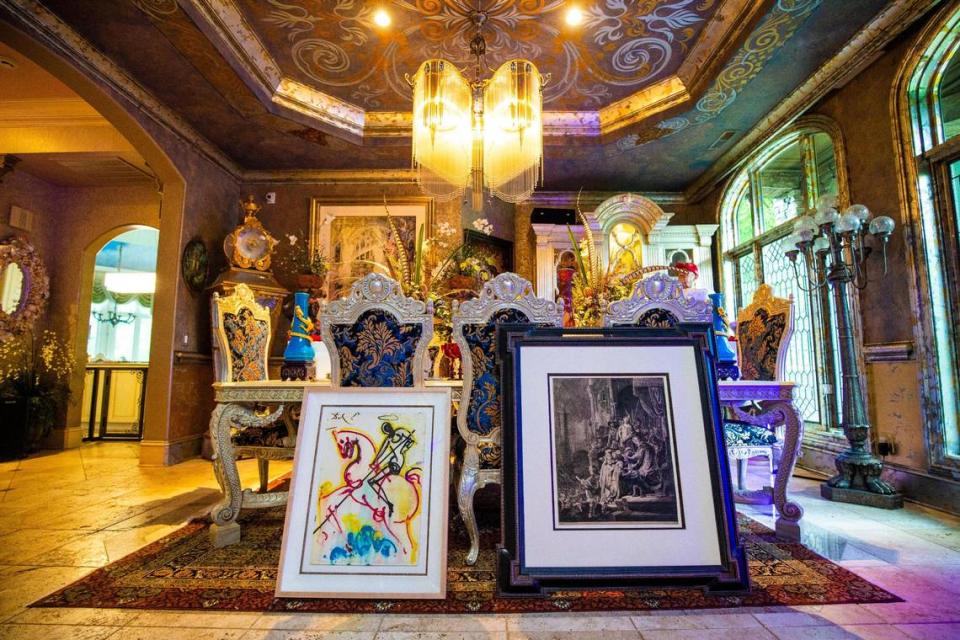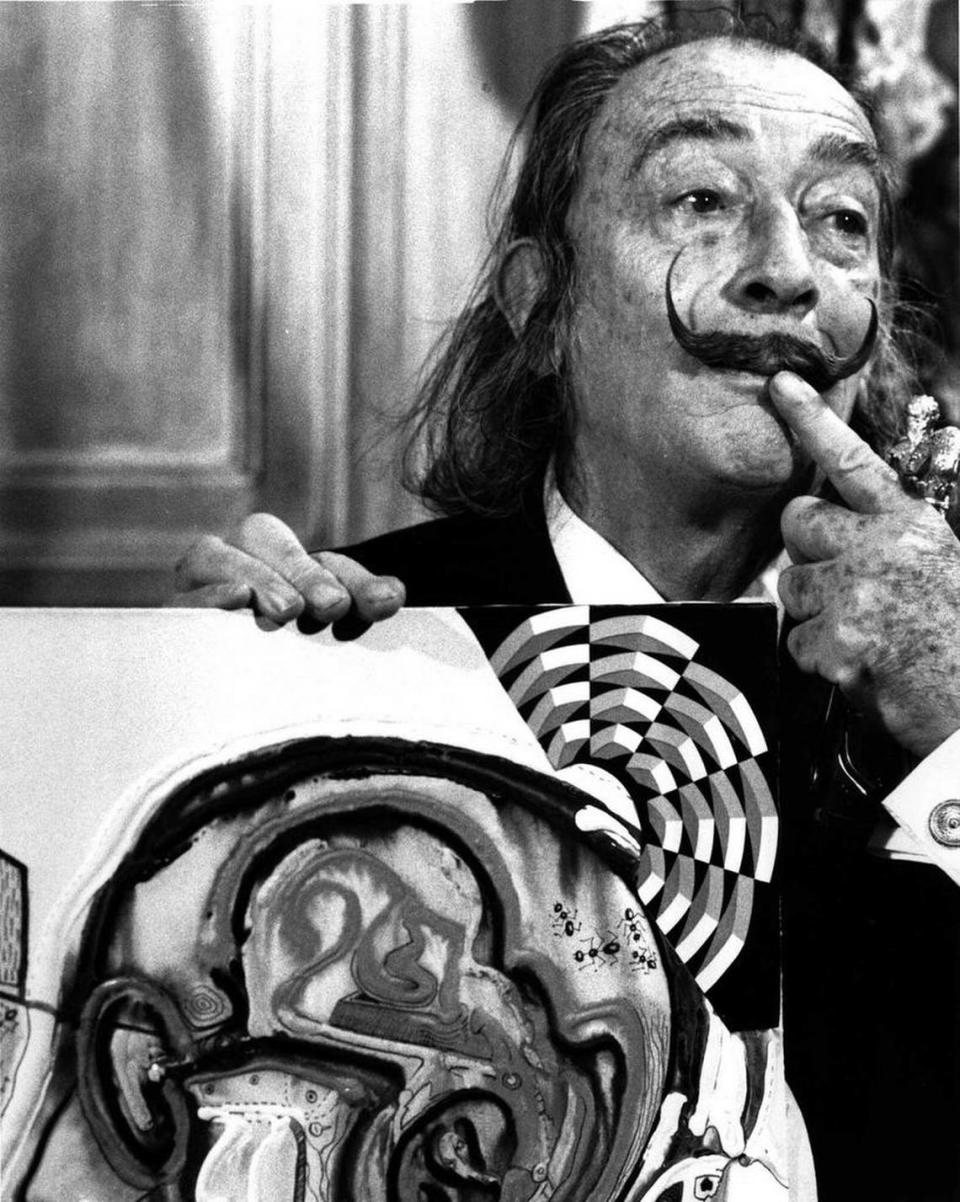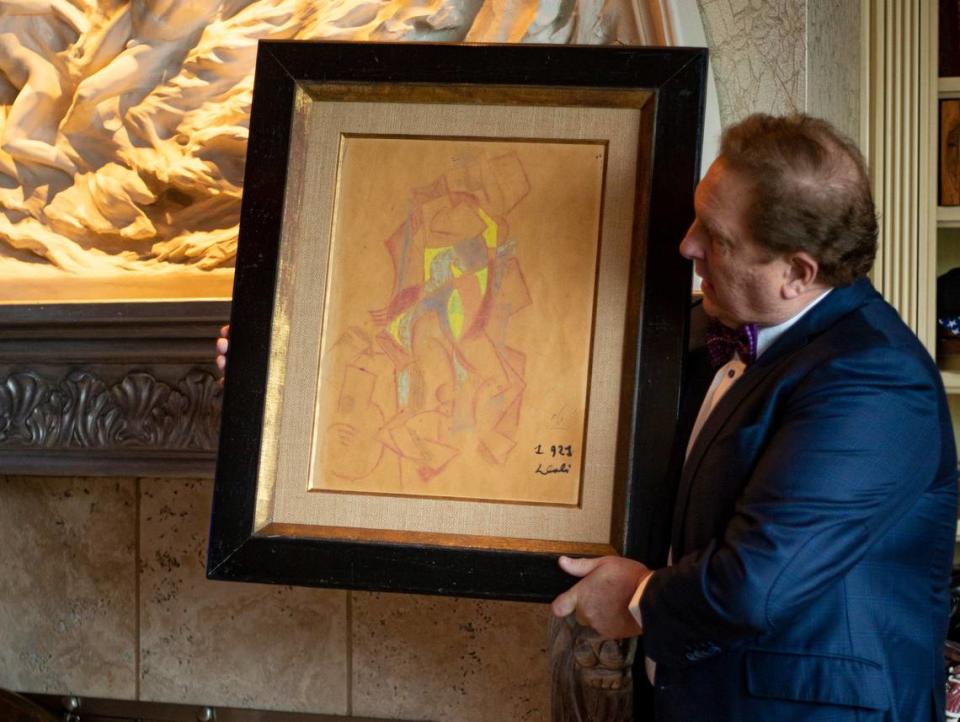NC doctor uses his vast art collection to decode Dalí’s legacy of surreal secrets
- Oops!Something went wrong.Please try again later.
On the edge of Lake Norman lies a vast, eclectic collection by one of the biggest, one of the strangest, one of the most visionary artists of the 20th century.
Mysteries embedded in Salvador Dalí’s prolific graphics, paintings and sculptures still intrigue viewers three decades after his death. Among the enchanted is Dr. Christopher Heath Brown, a noted art historian whose Cornelius mansion bulges with hundreds of Dalí creations.
“This is a guy who was a showman,” says Brown, “and a genius probably every bit as much as Leonardo da Vinci.”
Brown seeks to decode some of Dali’s artistic puzzles in his latest book, “The Dalí Legacy: How an Eccentric Genius Changed the Art World and Created a Lasting Legacy,” written with his longtime collaborator Jean-Pierre Isbouts and published by Apollo Publishers.

They explore Dalí’s indifference to the Spanish Civil War, his fraught ties to the post-World War II Franco regime, the stormy dysfunction of his family and the origins of his autoerotic themes.
Their detective work, meticulously researched, is a response to a challenge thrown down by Dalí himself when he reflected on the cult-like following of his admirers: “The secret of my influence has always been that it remained secret.”
A peculiar master
Dalí was one of the 20th century’s most influential, eccentric, flamboyant and versatile artists.
His bulging eyes and whiskered mustache established him as the iconic face of surrealism, a movement he pioneered with dismembered body parts, images of decay and profound sexual symbolism.
He was painting museum-quality landscapes at age 6 in his native Spain, got expelled twice from the prestigious San Fernando Academy of Art in Madrid in the 1920s for his rebellious nonconformity and believed he was the reincarnated spirit of his elder brother, also named Salvador, who died nine months before Dalí’s birth.

To Dalí, life itself was the greatest art. He was fond of stunts and performances that fed his image as a kooky genius.
In the 1930s, he and his wife, Gala, shocked New York by attending a masquerade ball dressed as the Lindbergh baby and his kidnapper. He once took an anteater on a walk through the Paris Metro.
Hired by the upscale store Bonwit Teller to design a showcase window, he became enraged by changes to his design and hurled a bathtub through the glass.
His talents touched many mediums — he designed furniture, clothing and jewelry. He understood the concept of becoming one’s own brand long before celebrities made it fashionable.
He embraced the nascent medium of television, appearing on game shows and late-night interviews.
He did a commercial beside Yankees pitcher Whitey Ford for the upstart Braniff Airlines and served as a pitchman for antacid. “Alka-Seltzer,” Dali said in the punchline, “is truly a work of art.”

Path to Dalí
Brown remembers the first piece of art he ever hung on a wall — that famous 1976 Farrah Fawcett swimsuit poster that decorated many a teenage boy’s room. He grew up in suburban Washington, D.C., in a family interested in fine art. Museums the city offered gave him a firm cultural foundation.
After graduating from dental school at UNC Chapel Hill in 1986, he began making enough money as an oral and maxillofacial surgeon that he could start an art collection of his own.
He acquired his first Dalí in the mid-’90s from the Centaur Gallery in Las Vegas, a watercolor of Christ with the fallen angel at the gates of Heaven. It was still on the wall when the entertainers Siegfried & Roy came in to browse, and they asked about purchasing it.
Told that it had just been sold, they approached Brown and offered him three times the $35,000 he had paid. “I told them it was my first major piece,” Brown says, “and it speaks to me personally. It wasn’t about the money.”

Since then, he has focused on Dalí and Renaissance masters. He’s collected other noted artists, including Pierre-Auguste Renoir, Albrecht Durer and Rembrandt van Rijn. For security reasons, Brown declined to state the estimated value of his collection.
Brown is particularly drawn to works with religious or mythological themes.
With Isbouts, he wrote three books on Da Vinci, “Young Leonardo,” “The Mona Lisa Myth” and “The Da Vinci Legacy.” They also collaborated on two PBS documentaries, “The Search for the Last Supper” and “The Search for the Mona Lisa.”
Among the mysteries explored in their new book, (which was published in March by Apollo Publishers) they examine subtle clues in Dalí’s most recognized piece, “The Persistence of Memory.”
Look closely at the melting timepieces, Brown says. “One reads 2 minutes to 6, one says 6 and the other 6:02. There is a past, a present and a future.”
When overlain on Leonardo Da Vinci and Andrea del Verrochio’s “Baptism of Christ,” the clocks occupy temporal spaces matching concepts of the past, present and everlasting. They fit likewise over Da Vinci’s “Adoration of the Magi.”
“Jean-Pierre and I have decoded some of Dali’s secrets,” Brown says. “There was a hidden, purposeful intent to what the artist was doing.”

House of art
From front foyer to back porch, Brown’s home is a vibrant gallery of artistic flair, sort of a cross between the modern Louvre and the Gothic Addams Family mansion. (It contains a sophisticated security system plus four dogs, in case you’re getting any ideas.)
Statuary, sculptures, paintings and murals are just some of the treasures.
In an Oz-themed nook is the Tin Man’s ax from the 1939 MGM classic movie “Wizard of Oz.” In a garage, you’ll find a snow white 1961 Rolls-Royce Silver Cloud. Marilyn Monroe’s first appearance in Playboy peers out from a wall frame, autographed by Hugh Hefner. Poke in the dresser and you’ll find Dalí-themed socks.
Brown has an expansive collection of Dalí’s graphics — work studies, lithographs, original drawings and watercolors, about 2,000 in all.
Some are sketches for later works; others contain jottings and notes. “They’re a real glimpse into the genius of Dalí,” Brown says.
He hopes someday they will land in a new museum in Monaco. Brown said he wants to meet up with Prince Albert II in the next year or two to discuss such an endeavor.
That would probably please Dalí — he was acquainted with Princess Grace; she was famously photographed with him at one of his shows in Paris.
At times, though, it didn’t take much to please Dalí. One secret the enigmatic artist shared at the height of his career: “Every morning when I wake up, I experience an exquisite joy — the joy of being Salvador Dalí — and I ask myself in rapture: What wonderful things is this Salvador Dalí going to accomplish today?”
This story is part of an Observer underwriting project with the Thrive Campaign for the Arts, supporting arts journalism in Charlotte.
More arts coverage
Want to see more stories like this? You can join our Facebook group, “Inside Charlotte Arts,” at https://www.facebook.com/groups/insidecharlottearts/

